Analysis & Change Management: CCIC's Agricultural Business in Europe
VerifiedAdded on 2023/06/14
|20
|4976
|74
Report
AI Summary
This report provides an analysis of CCIC's change management strategies for expanding its staple agricultural products business in Europe. It begins with a background of CCIC, highlighting its global presence and limited market share in the European port inspection market compared to competitors like SGS, BV, and Intertek. The analysis covers the status quo of the export market for staple agricultural products in Europe, focusing on key exporting countries such as Ukraine, France, Romania, and the Netherlands. It assesses CCIC's current situation in Europe regarding market promotion, customer exploitation, and core competitiveness, identifying challenges such as a lack of brand awareness, insufficient understanding of the local market, and unqualified inspectors. The report includes a business analysis of existing and potential customers, using COFCO as an example to illustrate the potential for business cooperation. A competitive analysis examines CCIC's position relative to its competitors and considers the bargaining power of suppliers and customers, as well as the threat of substitution. Finally, the report offers recommendations for improving CCIC's competitiveness and expanding its presence in the European agricultural products market.
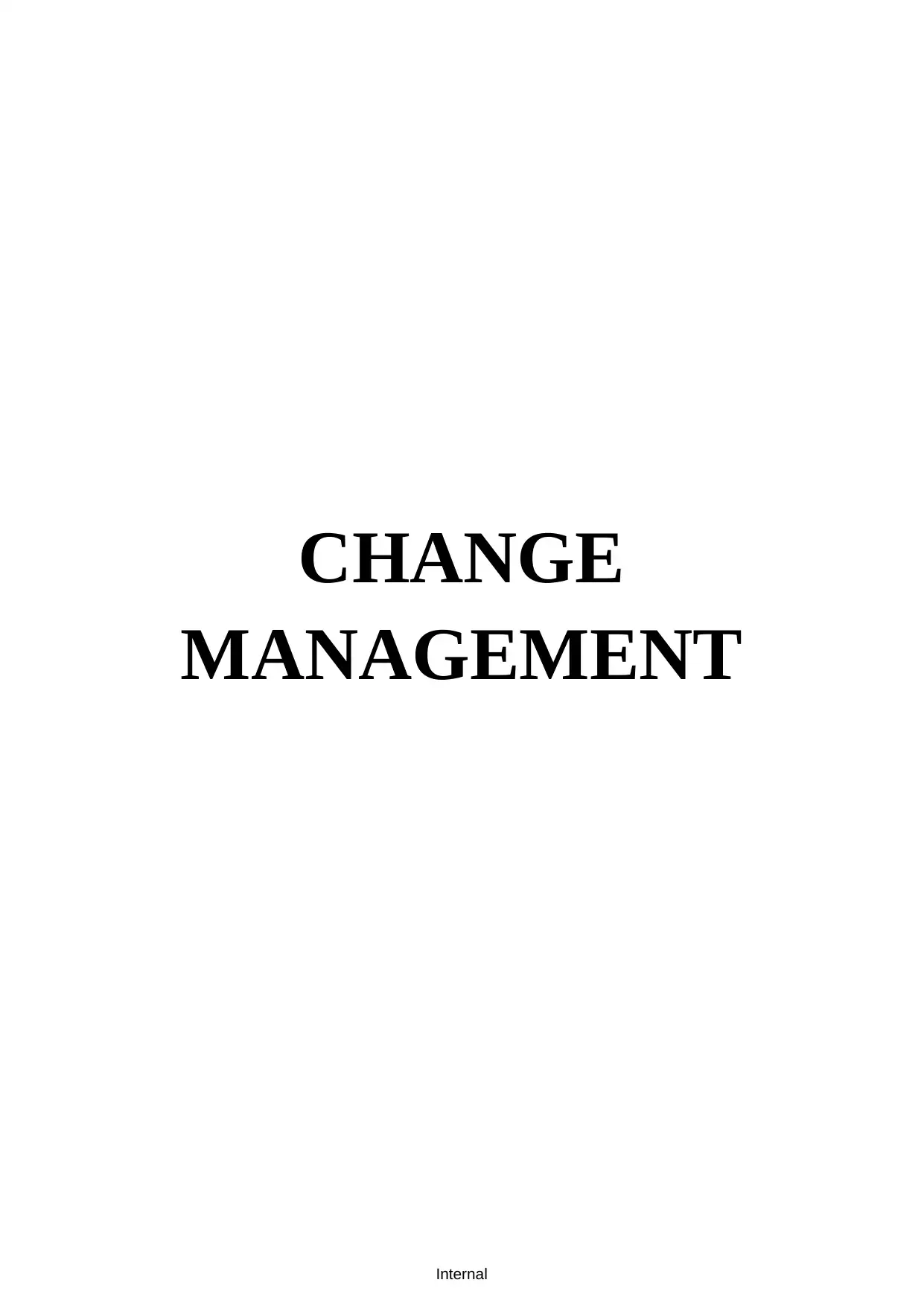
Internal
CHANGE
MANAGEMENT
CHANGE
MANAGEMENT
Paraphrase This Document
Need a fresh take? Get an instant paraphrase of this document with our AI Paraphraser
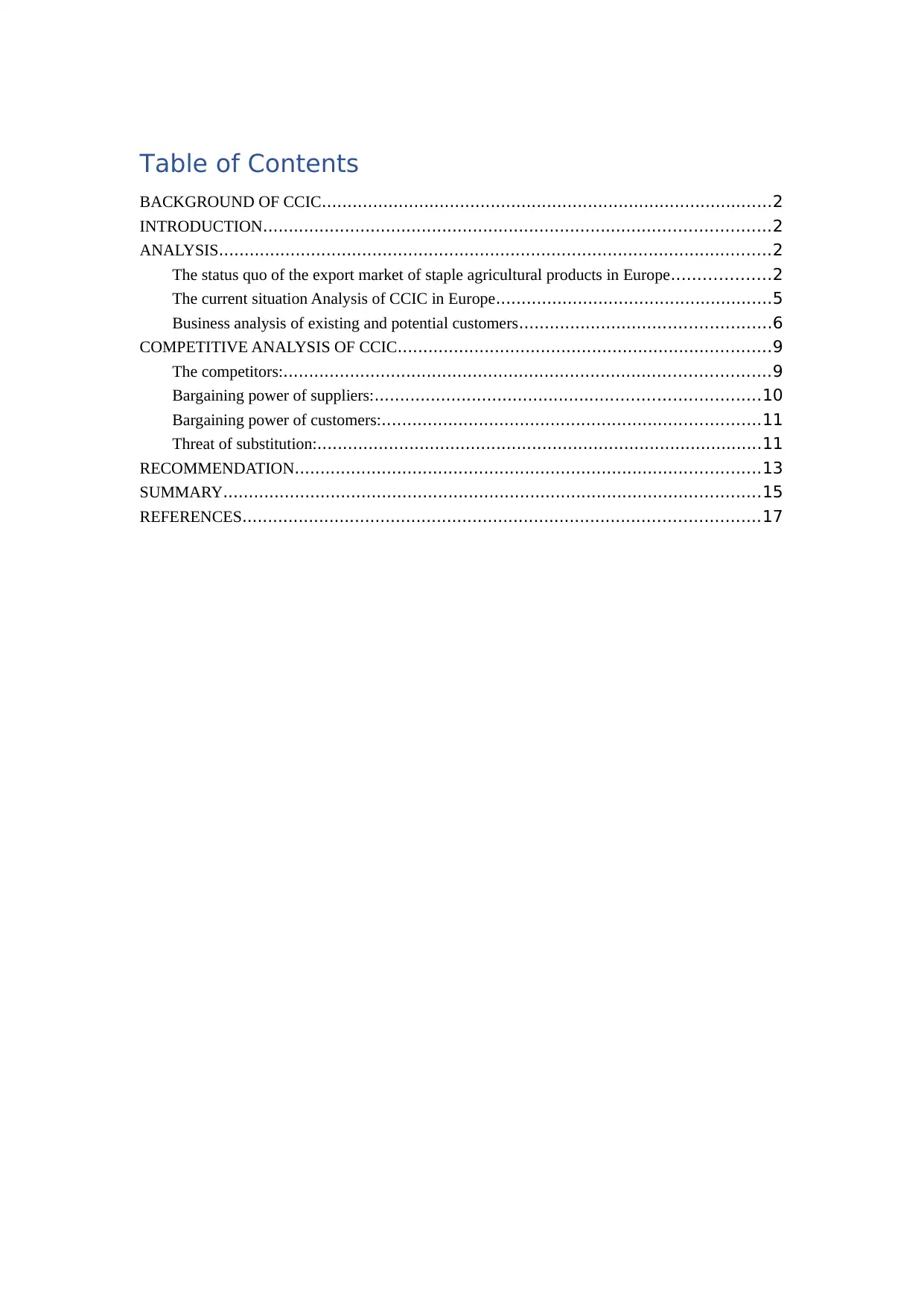
Table of Contents
BACKGROUND OF CCIC........................................................................................2
INTRODUCTION...................................................................................................2
ANALYSIS............................................................................................................2
The status quo of the export market of staple agricultural products in Europe...................2
The current situation Analysis of CCIC in Europe......................................................5
Business analysis of existing and potential customers.................................................6
COMPETITIVE ANALYSIS OF CCIC.........................................................................9
The competitors:...............................................................................................9
Bargaining power of suppliers:...........................................................................10
Bargaining power of customers:..........................................................................11
Threat of substitution:.......................................................................................11
RECOMMENDATION...........................................................................................13
SUMMARY.........................................................................................................15
REFERENCES.....................................................................................................17
BACKGROUND OF CCIC........................................................................................2
INTRODUCTION...................................................................................................2
ANALYSIS............................................................................................................2
The status quo of the export market of staple agricultural products in Europe...................2
The current situation Analysis of CCIC in Europe......................................................5
Business analysis of existing and potential customers.................................................6
COMPETITIVE ANALYSIS OF CCIC.........................................................................9
The competitors:...............................................................................................9
Bargaining power of suppliers:...........................................................................10
Bargaining power of customers:..........................................................................11
Threat of substitution:.......................................................................................11
RECOMMENDATION...........................................................................................13
SUMMARY.........................................................................................................15
REFERENCES.....................................................................................................17
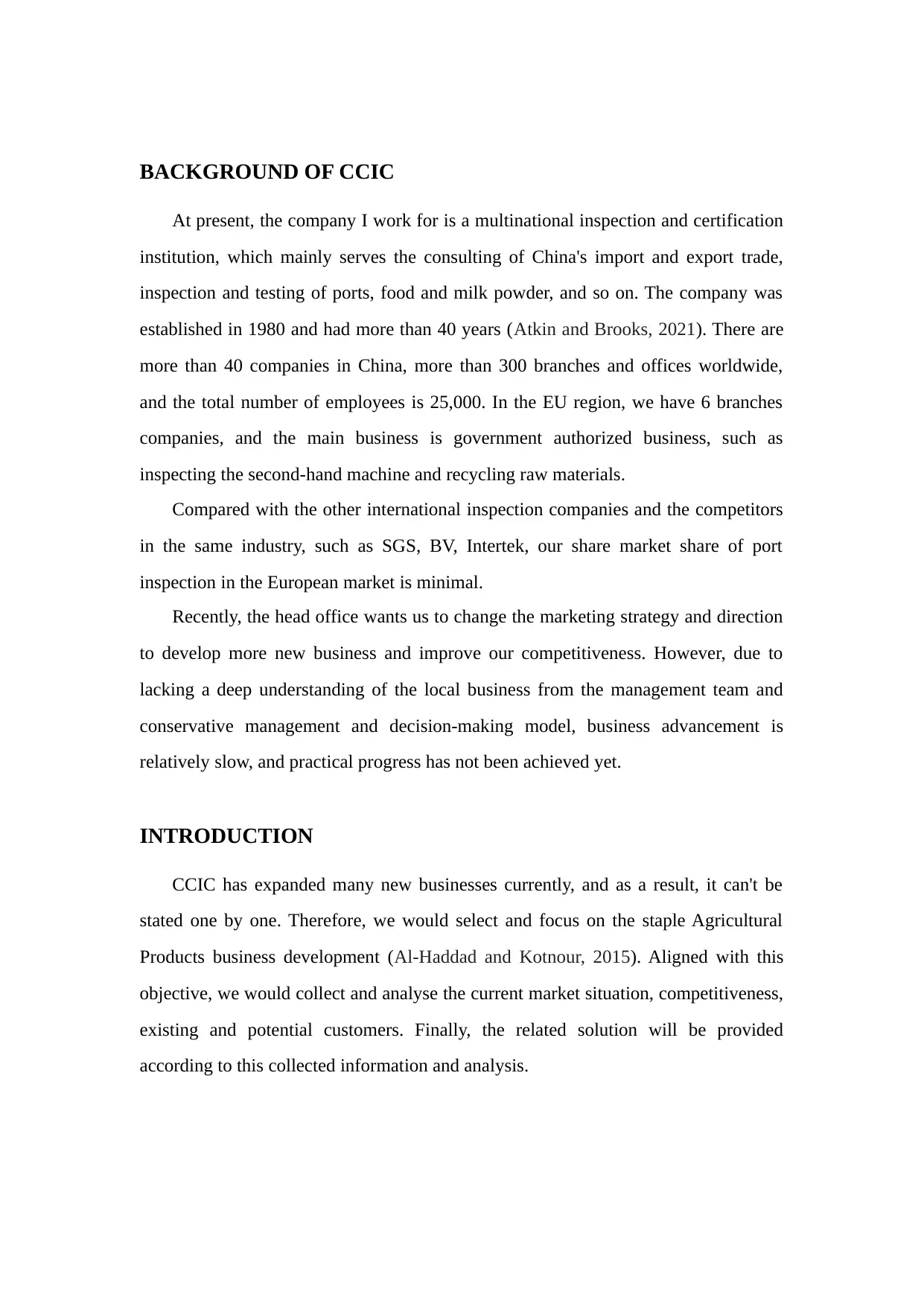
BACKGROUND OF CCIC
At present, the company I work for is a multinational inspection and certification
institution, which mainly serves the consulting of China's import and export trade,
inspection and testing of ports, food and milk powder, and so on. The company was
established in 1980 and had more than 40 years (Atkin and Brooks, 2021). There are
more than 40 companies in China, more than 300 branches and offices worldwide,
and the total number of employees is 25,000. In the EU region, we have 6 branches
companies, and the main business is government authorized business, such as
inspecting the second-hand machine and recycling raw materials.
Compared with the other international inspection companies and the competitors
in the same industry, such as SGS, BV, Intertek, our share market share of port
inspection in the European market is minimal.
Recently, the head office wants us to change the marketing strategy and direction
to develop more new business and improve our competitiveness. However, due to
lacking a deep understanding of the local business from the management team and
conservative management and decision-making model, business advancement is
relatively slow, and practical progress has not been achieved yet.
INTRODUCTION
CCIC has expanded many new businesses currently, and as a result, it can't be
stated one by one. Therefore, we would select and focus on the staple Agricultural
Products business development (Al-Haddad and Kotnour, 2015). Aligned with this
objective, we would collect and analyse the current market situation, competitiveness,
existing and potential customers. Finally, the related solution will be provided
according to this collected information and analysis.
At present, the company I work for is a multinational inspection and certification
institution, which mainly serves the consulting of China's import and export trade,
inspection and testing of ports, food and milk powder, and so on. The company was
established in 1980 and had more than 40 years (Atkin and Brooks, 2021). There are
more than 40 companies in China, more than 300 branches and offices worldwide,
and the total number of employees is 25,000. In the EU region, we have 6 branches
companies, and the main business is government authorized business, such as
inspecting the second-hand machine and recycling raw materials.
Compared with the other international inspection companies and the competitors
in the same industry, such as SGS, BV, Intertek, our share market share of port
inspection in the European market is minimal.
Recently, the head office wants us to change the marketing strategy and direction
to develop more new business and improve our competitiveness. However, due to
lacking a deep understanding of the local business from the management team and
conservative management and decision-making model, business advancement is
relatively slow, and practical progress has not been achieved yet.
INTRODUCTION
CCIC has expanded many new businesses currently, and as a result, it can't be
stated one by one. Therefore, we would select and focus on the staple Agricultural
Products business development (Al-Haddad and Kotnour, 2015). Aligned with this
objective, we would collect and analyse the current market situation, competitiveness,
existing and potential customers. Finally, the related solution will be provided
according to this collected information and analysis.
⊘ This is a preview!⊘
Do you want full access?
Subscribe today to unlock all pages.

Trusted by 1+ million students worldwide
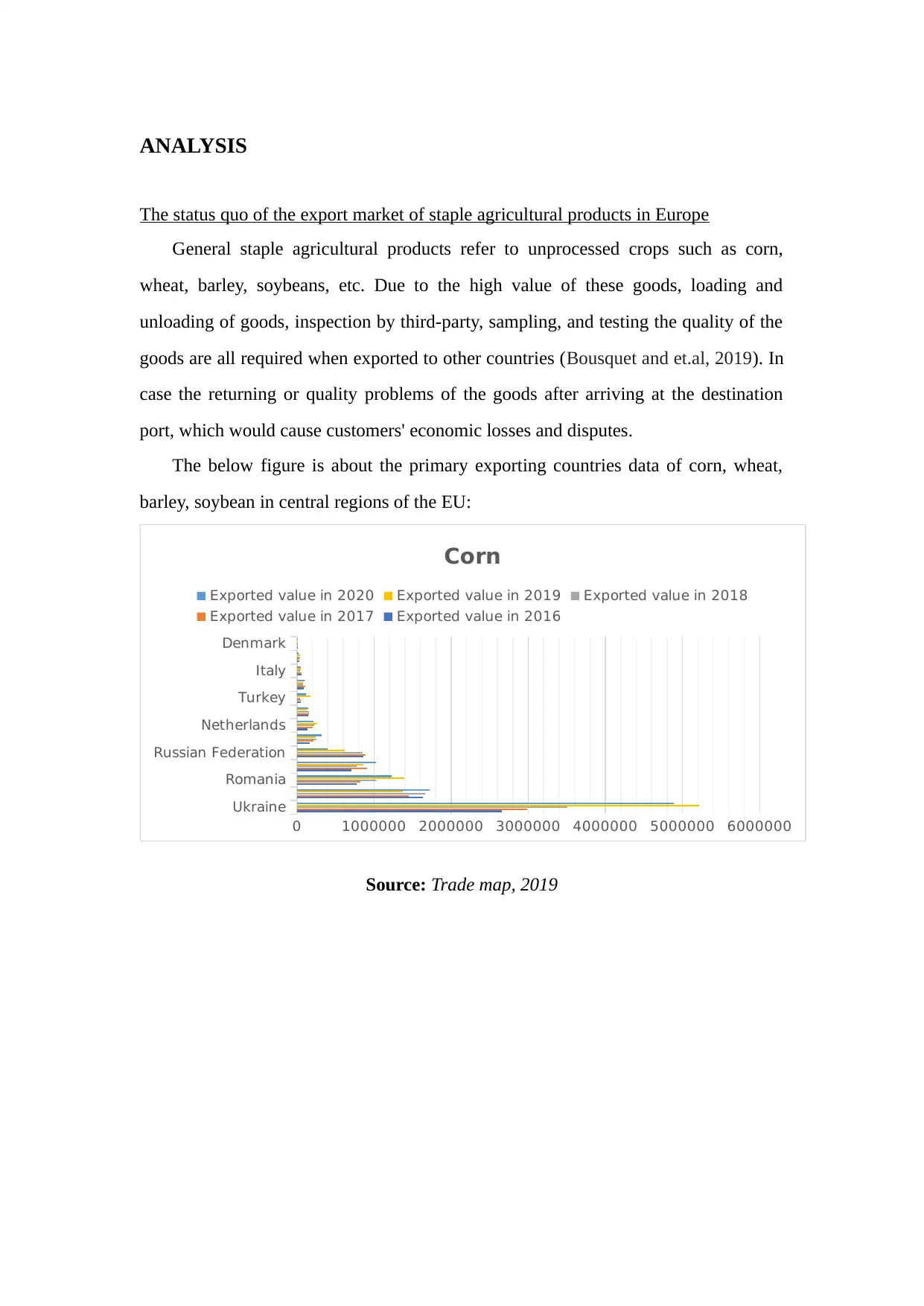
ANALYSIS
The status quo of the export market of staple agricultural products in Europe
General staple agricultural products refer to unprocessed crops such as corn,
wheat, barley, soybeans, etc. Due to the high value of these goods, loading and
unloading of goods, inspection by third-party, sampling, and testing the quality of the
goods are all required when exported to other countries (Bousquet and et.al, 2019). In
case the returning or quality problems of the goods after arriving at the destination
port, which would cause customers' economic losses and disputes.
The below figure is about the primary exporting countries data of corn, wheat,
barley, soybean in central regions of the EU:
Ukraine
Romania
Russian Federation
Netherlands
Turkey
Italy
Denmark
0 1000000 2000000 3000000 4000000 5000000 6000000
Corn
Exported value in 2020 Exported value in 2019 Exported value in 2018
Exported value in 2017 Exported value in 2016
Source: Trade map, 2019
The status quo of the export market of staple agricultural products in Europe
General staple agricultural products refer to unprocessed crops such as corn,
wheat, barley, soybeans, etc. Due to the high value of these goods, loading and
unloading of goods, inspection by third-party, sampling, and testing the quality of the
goods are all required when exported to other countries (Bousquet and et.al, 2019). In
case the returning or quality problems of the goods after arriving at the destination
port, which would cause customers' economic losses and disputes.
The below figure is about the primary exporting countries data of corn, wheat,
barley, soybean in central regions of the EU:
Ukraine
Romania
Russian Federation
Netherlands
Turkey
Italy
Denmark
0 1000000 2000000 3000000 4000000 5000000 6000000
Corn
Exported value in 2020 Exported value in 2019 Exported value in 2018
Exported value in 2017 Exported value in 2016
Source: Trade map, 2019
Paraphrase This Document
Need a fresh take? Get an instant paraphrase of this document with our AI Paraphraser
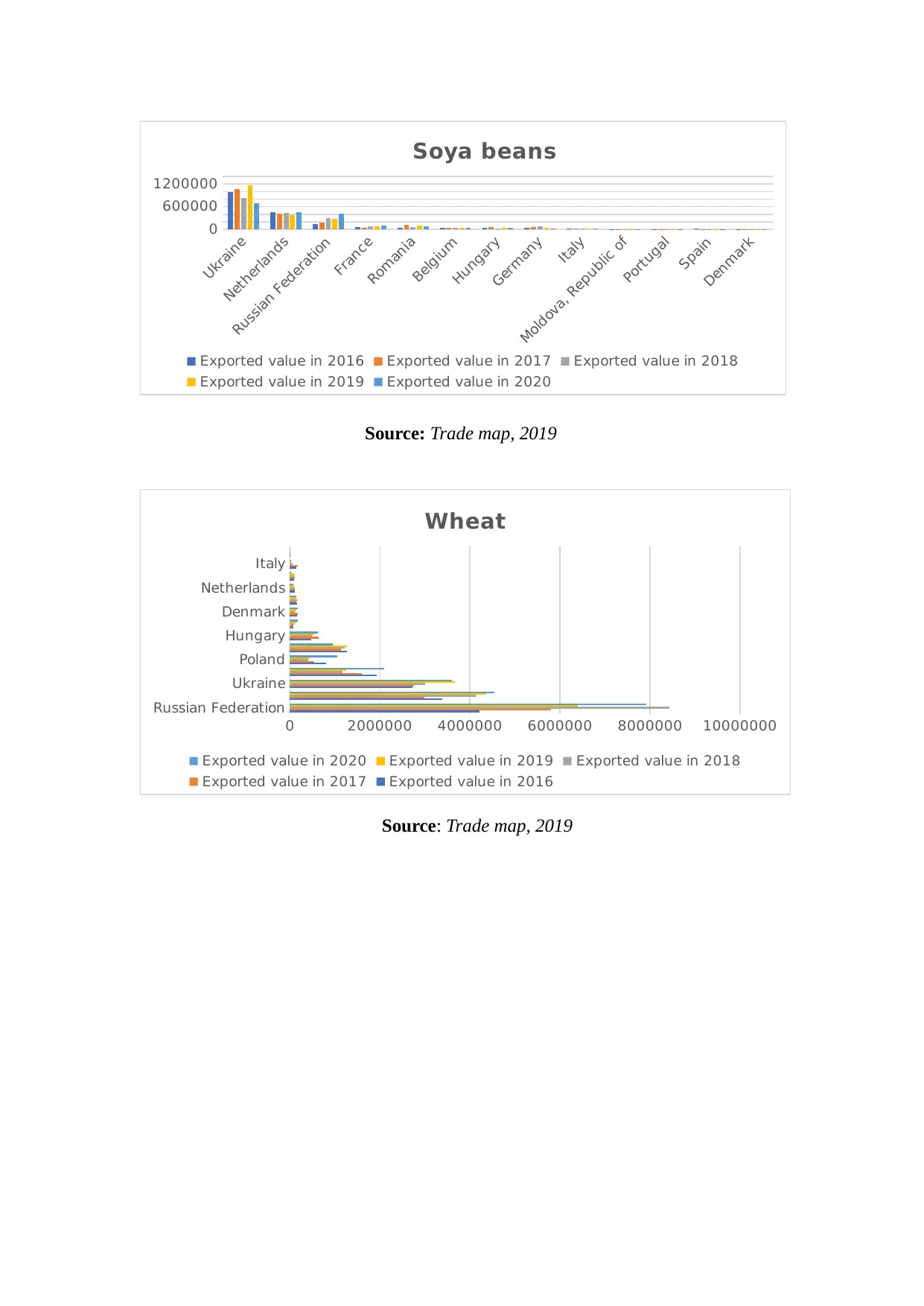
Ukraine
Netherlands
Russian Federation
France
Romania
Belgium
Hungary
Germany
Italy
Moldova, Republic of
Portugal
Spain
Denmark
0
600000
1200000
Soya beans
Exported value in 2016 Exported value in 2017 Exported value in 2018
Exported value in 2019 Exported value in 2020
Source: Trade map, 2019
Russian Federation
Ukraine
Poland
Hungary
Denmark
Netherlands
Italy
0 2000000 4000000 6000000 8000000 10000000
Wheat
Exported value in 2020 Exported value in 2019 Exported value in 2018
Exported value in 2017 Exported value in 2016
Source: Trade map, 2019
Netherlands
Russian Federation
France
Romania
Belgium
Hungary
Germany
Italy
Moldova, Republic of
Portugal
Spain
Denmark
0
600000
1200000
Soya beans
Exported value in 2016 Exported value in 2017 Exported value in 2018
Exported value in 2019 Exported value in 2020
Source: Trade map, 2019
Russian Federation
Ukraine
Poland
Hungary
Denmark
Netherlands
Italy
0 2000000 4000000 6000000 8000000 10000000
Wheat
Exported value in 2020 Exported value in 2019 Exported value in 2018
Exported value in 2017 Exported value in 2016
Source: Trade map, 2019
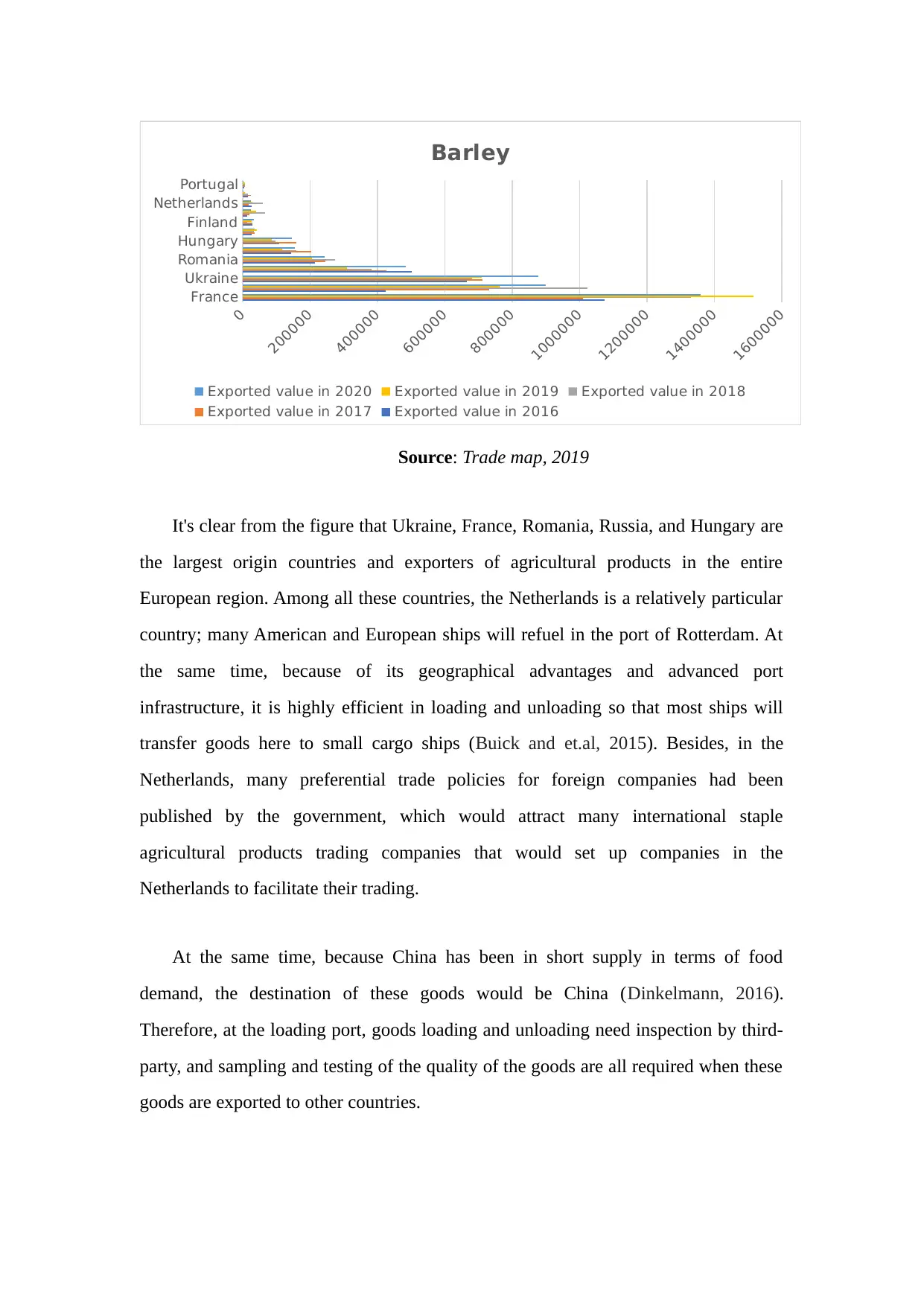
France
Ukraine
Romania
Hungary
Finland
Netherlands
Portugal
0
200000
400000
600000
800000
1000000
1200000
1400000
1600000
Barley
Exported value in 2020 Exported value in 2019 Exported value in 2018
Exported value in 2017 Exported value in 2016
Source: Trade map, 2019
It's clear from the figure that Ukraine, France, Romania, Russia, and Hungary are
the largest origin countries and exporters of agricultural products in the entire
European region. Among all these countries, the Netherlands is a relatively particular
country; many American and European ships will refuel in the port of Rotterdam. At
the same time, because of its geographical advantages and advanced port
infrastructure, it is highly efficient in loading and unloading so that most ships will
transfer goods here to small cargo ships (Buick and et.al, 2015). Besides, in the
Netherlands, many preferential trade policies for foreign companies had been
published by the government, which would attract many international staple
agricultural products trading companies that would set up companies in the
Netherlands to facilitate their trading.
At the same time, because China has been in short supply in terms of food
demand, the destination of these goods would be China (Dinkelmann, 2016).
Therefore, at the loading port, goods loading and unloading need inspection by third-
party, and sampling and testing of the quality of the goods are all required when these
goods are exported to other countries.
Ukraine
Romania
Hungary
Finland
Netherlands
Portugal
0
200000
400000
600000
800000
1000000
1200000
1400000
1600000
Barley
Exported value in 2020 Exported value in 2019 Exported value in 2018
Exported value in 2017 Exported value in 2016
Source: Trade map, 2019
It's clear from the figure that Ukraine, France, Romania, Russia, and Hungary are
the largest origin countries and exporters of agricultural products in the entire
European region. Among all these countries, the Netherlands is a relatively particular
country; many American and European ships will refuel in the port of Rotterdam. At
the same time, because of its geographical advantages and advanced port
infrastructure, it is highly efficient in loading and unloading so that most ships will
transfer goods here to small cargo ships (Buick and et.al, 2015). Besides, in the
Netherlands, many preferential trade policies for foreign companies had been
published by the government, which would attract many international staple
agricultural products trading companies that would set up companies in the
Netherlands to facilitate their trading.
At the same time, because China has been in short supply in terms of food
demand, the destination of these goods would be China (Dinkelmann, 2016).
Therefore, at the loading port, goods loading and unloading need inspection by third-
party, and sampling and testing of the quality of the goods are all required when these
goods are exported to other countries.
⊘ This is a preview!⊘
Do you want full access?
Subscribe today to unlock all pages.

Trusted by 1+ million students worldwide
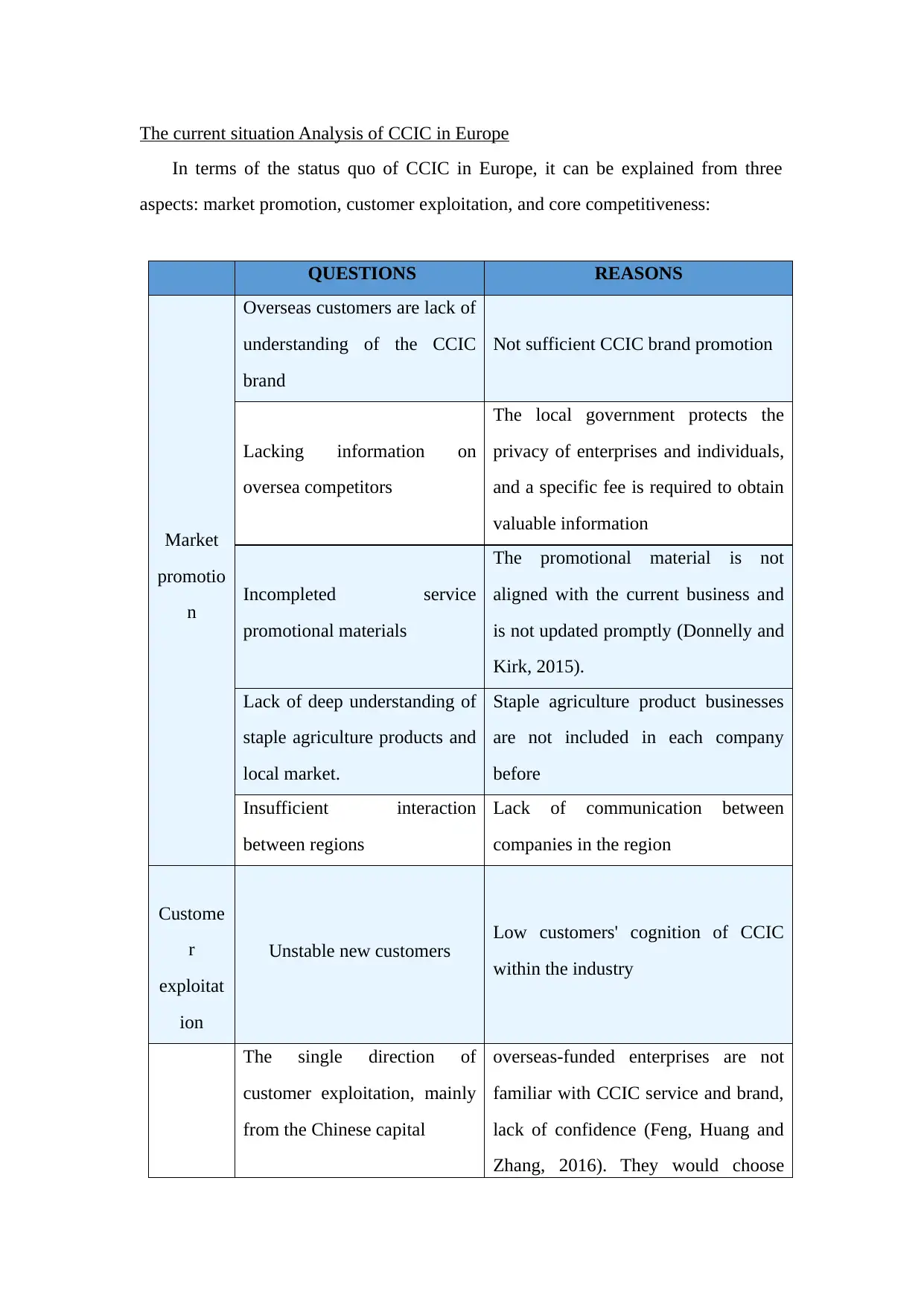
The current situation Analysis of CCIC in Europe
In terms of the status quo of CCIC in Europe, it can be explained from three
aspects: market promotion, customer exploitation, and core competitiveness:
QUESTIONS REASONS
Market
promotio
n
Overseas customers are lack of
understanding of the CCIC
brand
Not sufficient CCIC brand promotion
Lacking information on
oversea competitors
The local government protects the
privacy of enterprises and individuals,
and a specific fee is required to obtain
valuable information
Incompleted service
promotional materials
The promotional material is not
aligned with the current business and
is not updated promptly (Donnelly and
Kirk, 2015).
Lack of deep understanding of
staple agriculture products and
local market.
Staple agriculture product businesses
are not included in each company
before
Insufficient interaction
between regions
Lack of communication between
companies in the region
Custome
r
exploitat
ion
Unstable new customers Low customers' cognition of CCIC
within the industry
The single direction of
customer exploitation, mainly
from the Chinese capital
overseas-funded enterprises are not
familiar with CCIC service and brand,
lack of confidence (Feng, Huang and
Zhang, 2016). They would choose
In terms of the status quo of CCIC in Europe, it can be explained from three
aspects: market promotion, customer exploitation, and core competitiveness:
QUESTIONS REASONS
Market
promotio
n
Overseas customers are lack of
understanding of the CCIC
brand
Not sufficient CCIC brand promotion
Lacking information on
oversea competitors
The local government protects the
privacy of enterprises and individuals,
and a specific fee is required to obtain
valuable information
Incompleted service
promotional materials
The promotional material is not
aligned with the current business and
is not updated promptly (Donnelly and
Kirk, 2015).
Lack of deep understanding of
staple agriculture products and
local market.
Staple agriculture product businesses
are not included in each company
before
Insufficient interaction
between regions
Lack of communication between
companies in the region
Custome
r
exploitat
ion
Unstable new customers Low customers' cognition of CCIC
within the industry
The single direction of
customer exploitation, mainly
from the Chinese capital
overseas-funded enterprises are not
familiar with CCIC service and brand,
lack of confidence (Feng, Huang and
Zhang, 2016). They would choose
Paraphrase This Document
Need a fresh take? Get an instant paraphrase of this document with our AI Paraphraser
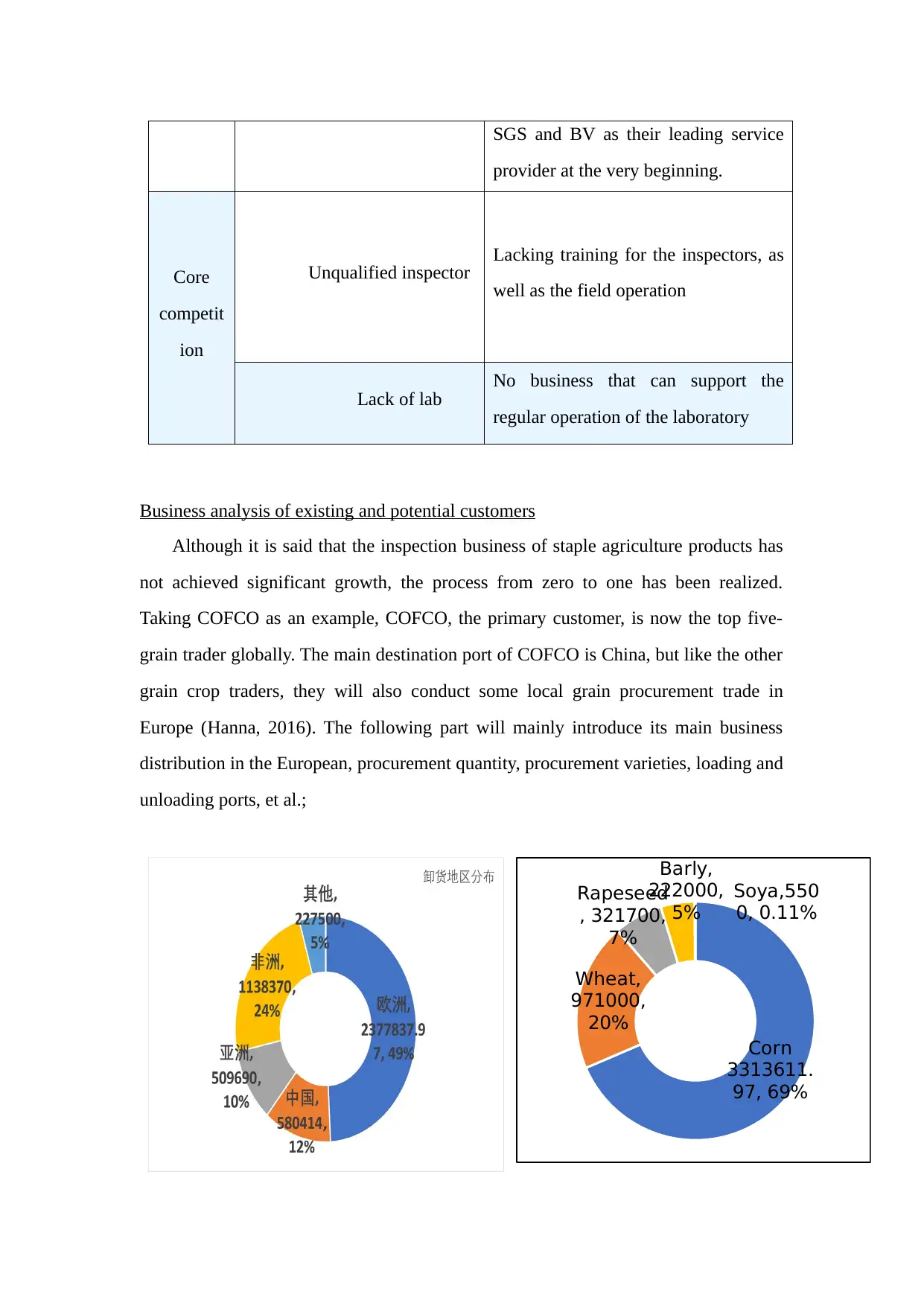
SGS and BV as their leading service
provider at the very beginning.
Core
competit
ion
Unqualified inspector Lacking training for the inspectors, as
well as the field operation
Lack of lab No business that can support the
regular operation of the laboratory
Business analysis of existing and potential customers
Although it is said that the inspection business of staple agriculture products has
not achieved significant growth, the process from zero to one has been realized.
Taking COFCO as an example, COFCO, the primary customer, is now the top five-
grain trader globally. The main destination port of COFCO is China, but like the other
grain crop traders, they will also conduct some local grain procurement trade in
Europe (Hanna, 2016). The following part will mainly introduce its main business
distribution in the European, procurement quantity, procurement varieties, loading and
unloading ports, et al.;
Corn
3313611.
97, 69%
Wheat,
971000,
20%
Rapeseed
, 321700,
7%
Barly,
222000,
5%
Soya,550
0, 0.11%
provider at the very beginning.
Core
competit
ion
Unqualified inspector Lacking training for the inspectors, as
well as the field operation
Lack of lab No business that can support the
regular operation of the laboratory
Business analysis of existing and potential customers
Although it is said that the inspection business of staple agriculture products has
not achieved significant growth, the process from zero to one has been realized.
Taking COFCO as an example, COFCO, the primary customer, is now the top five-
grain trader globally. The main destination port of COFCO is China, but like the other
grain crop traders, they will also conduct some local grain procurement trade in
Europe (Hanna, 2016). The following part will mainly introduce its main business
distribution in the European, procurement quantity, procurement varieties, loading and
unloading ports, et al.;
Corn
3313611.
97, 69%
Wheat,
971000,
20%
Rapeseed
, 321700,
7%
Barly,
222000,
5%
Soya,550
0, 0.11%
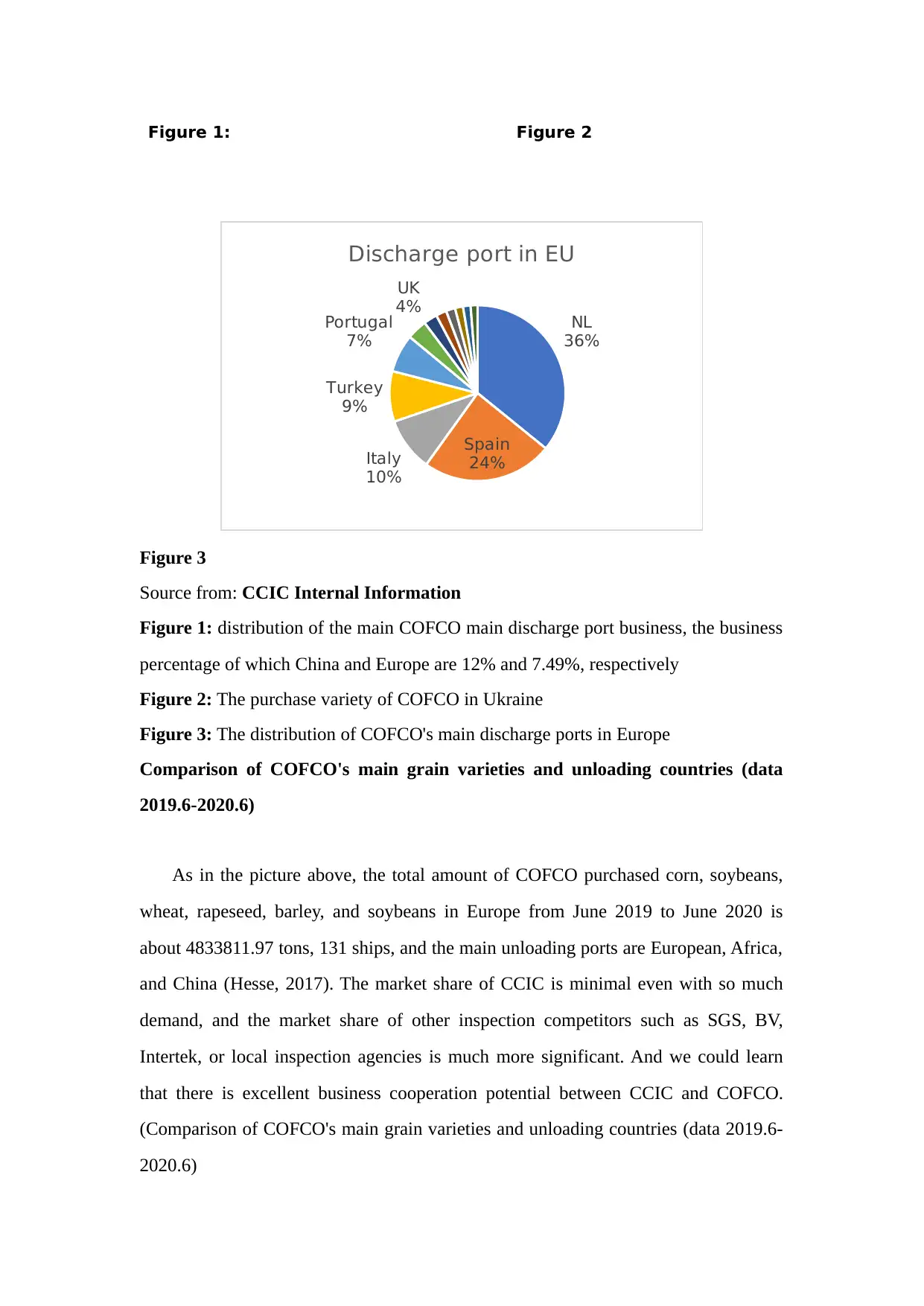
Figure 1: Figure 2
NL
36%
Spain
24%Italy
10%
Turkey
9%
Portugal
7%
UK
4%
Discharge port in EU
Figure 3
Source from: CCIC Internal Information
Figure 1: distribution of the main COFCO main discharge port business, the business
percentage of which China and Europe are 12% and 7.49%, respectively
Figure 2: The purchase variety of COFCO in Ukraine
Figure 3: The distribution of COFCO's main discharge ports in Europe
Comparison of COFCO's main grain varieties and unloading countries (data
2019.6-2020.6)
As in the picture above, the total amount of COFCO purchased corn, soybeans,
wheat, rapeseed, barley, and soybeans in Europe from June 2019 to June 2020 is
about 4833811.97 tons, 131 ships, and the main unloading ports are European, Africa,
and China (Hesse, 2017). The market share of CCIC is minimal even with so much
demand, and the market share of other inspection competitors such as SGS, BV,
Intertek, or local inspection agencies is much more significant. And we could learn
that there is excellent business cooperation potential between CCIC and COFCO.
(Comparison of COFCO's main grain varieties and unloading countries (data 2019.6-
2020.6)
NL
36%
Spain
24%Italy
10%
Turkey
9%
Portugal
7%
UK
4%
Discharge port in EU
Figure 3
Source from: CCIC Internal Information
Figure 1: distribution of the main COFCO main discharge port business, the business
percentage of which China and Europe are 12% and 7.49%, respectively
Figure 2: The purchase variety of COFCO in Ukraine
Figure 3: The distribution of COFCO's main discharge ports in Europe
Comparison of COFCO's main grain varieties and unloading countries (data
2019.6-2020.6)
As in the picture above, the total amount of COFCO purchased corn, soybeans,
wheat, rapeseed, barley, and soybeans in Europe from June 2019 to June 2020 is
about 4833811.97 tons, 131 ships, and the main unloading ports are European, Africa,
and China (Hesse, 2017). The market share of CCIC is minimal even with so much
demand, and the market share of other inspection competitors such as SGS, BV,
Intertek, or local inspection agencies is much more significant. And we could learn
that there is excellent business cooperation potential between CCIC and COFCO.
(Comparison of COFCO's main grain varieties and unloading countries (data 2019.6-
2020.6)
⊘ This is a preview!⊘
Do you want full access?
Subscribe today to unlock all pages.

Trusted by 1+ million students worldwide
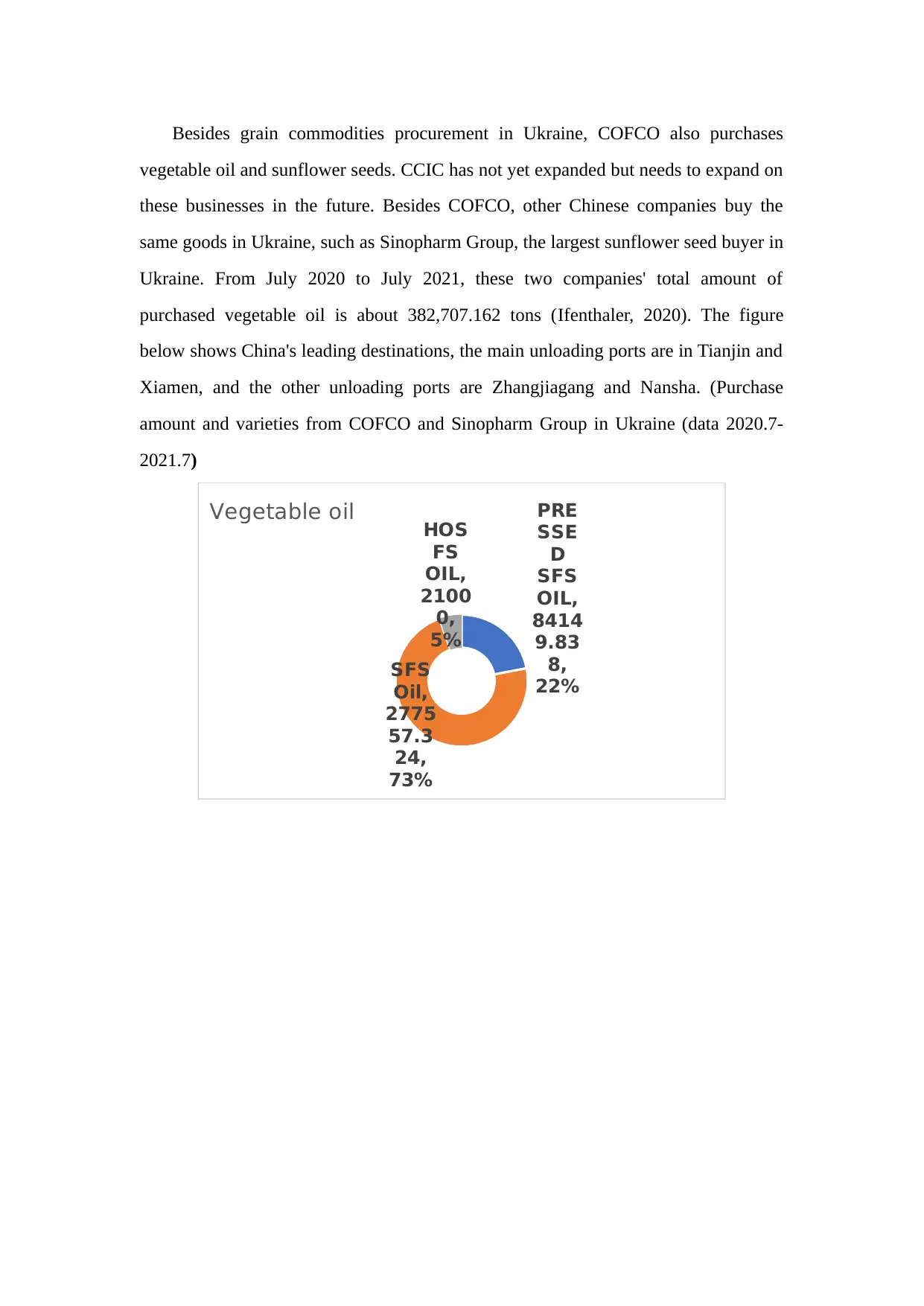
Besides grain commodities procurement in Ukraine, COFCO also purchases
vegetable oil and sunflower seeds. CCIC has not yet expanded but needs to expand on
these businesses in the future. Besides COFCO, other Chinese companies buy the
same goods in Ukraine, such as Sinopharm Group, the largest sunflower seed buyer in
Ukraine. From July 2020 to July 2021, these two companies' total amount of
purchased vegetable oil is about 382,707.162 tons (Ifenthaler, 2020). The figure
below shows China's leading destinations, the main unloading ports are in Tianjin and
Xiamen, and the other unloading ports are Zhangjiagang and Nansha. (Purchase
amount and varieties from COFCO and Sinopharm Group in Ukraine (data 2020.7-
2021.7)
PRE
SSE
D
SFS
OIL,
8414
9.83
8,
22%
SFS
Oil,
2775
57.3
24,
73%
HOS
FS
OIL,
2100
0,
5%
Vegetable oil
vegetable oil and sunflower seeds. CCIC has not yet expanded but needs to expand on
these businesses in the future. Besides COFCO, other Chinese companies buy the
same goods in Ukraine, such as Sinopharm Group, the largest sunflower seed buyer in
Ukraine. From July 2020 to July 2021, these two companies' total amount of
purchased vegetable oil is about 382,707.162 tons (Ifenthaler, 2020). The figure
below shows China's leading destinations, the main unloading ports are in Tianjin and
Xiamen, and the other unloading ports are Zhangjiagang and Nansha. (Purchase
amount and varieties from COFCO and Sinopharm Group in Ukraine (data 2020.7-
2021.7)
PRE
SSE
D
SFS
OIL,
8414
9.83
8,
22%
SFS
Oil,
2775
57.3
24,
73%
HOS
FS
OIL,
2100
0,
5%
Vegetable oil
Paraphrase This Document
Need a fresh take? Get an instant paraphrase of this document with our AI Paraphraser
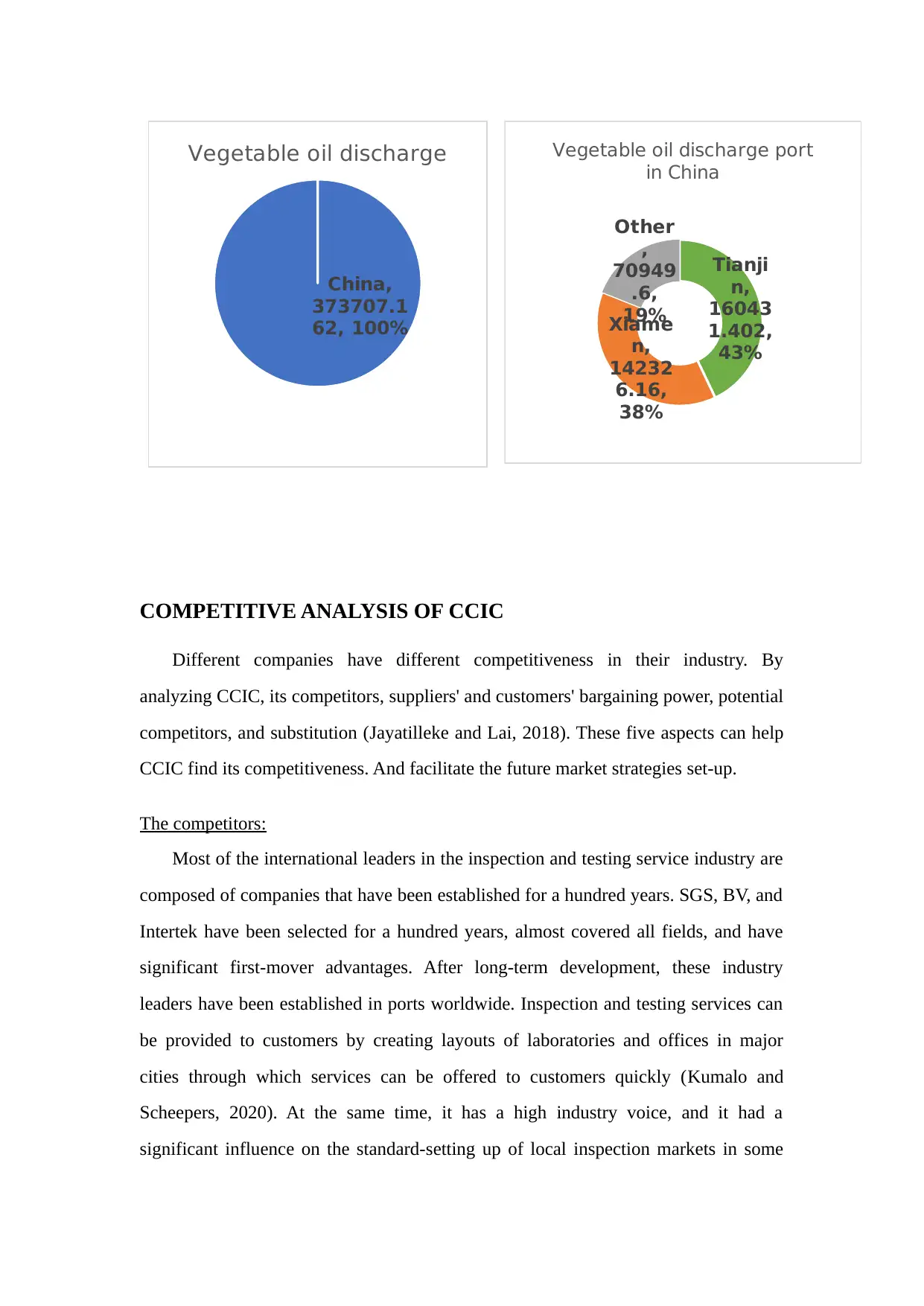
China,
373707.1
62, 100%
Vegetable oil discharge
Tianji
n,
16043
1.402,
43%
Xiame
n,
14232
6.16,
38%
Other
,
70949
.6,
19%
Vegetable oil discharge port
in China
COMPETITIVE ANALYSIS OF CCIC
Different companies have different competitiveness in their industry. By
analyzing CCIC, its competitors, suppliers' and customers' bargaining power, potential
competitors, and substitution (Jayatilleke and Lai, 2018). These five aspects can help
CCIC find its competitiveness. And facilitate the future market strategies set-up.
The competitors:
Most of the international leaders in the inspection and testing service industry are
composed of companies that have been established for a hundred years. SGS, BV, and
Intertek have been selected for a hundred years, almost covered all fields, and have
significant first-mover advantages. After long-term development, these industry
leaders have been established in ports worldwide. Inspection and testing services can
be provided to customers by creating layouts of laboratories and offices in major
cities through which services can be offered to customers quickly (Kumalo and
Scheepers, 2020). At the same time, it has a high industry voice, and it had a
significant influence on the standard-setting up of local inspection markets in some
373707.1
62, 100%
Vegetable oil discharge
Tianji
n,
16043
1.402,
43%
Xiame
n,
14232
6.16,
38%
Other
,
70949
.6,
19%
Vegetable oil discharge port
in China
COMPETITIVE ANALYSIS OF CCIC
Different companies have different competitiveness in their industry. By
analyzing CCIC, its competitors, suppliers' and customers' bargaining power, potential
competitors, and substitution (Jayatilleke and Lai, 2018). These five aspects can help
CCIC find its competitiveness. And facilitate the future market strategies set-up.
The competitors:
Most of the international leaders in the inspection and testing service industry are
composed of companies that have been established for a hundred years. SGS, BV, and
Intertek have been selected for a hundred years, almost covered all fields, and have
significant first-mover advantages. After long-term development, these industry
leaders have been established in ports worldwide. Inspection and testing services can
be provided to customers by creating layouts of laboratories and offices in major
cities through which services can be offered to customers quickly (Kumalo and
Scheepers, 2020). At the same time, it has a high industry voice, and it had a
significant influence on the standard-setting up of local inspection markets in some
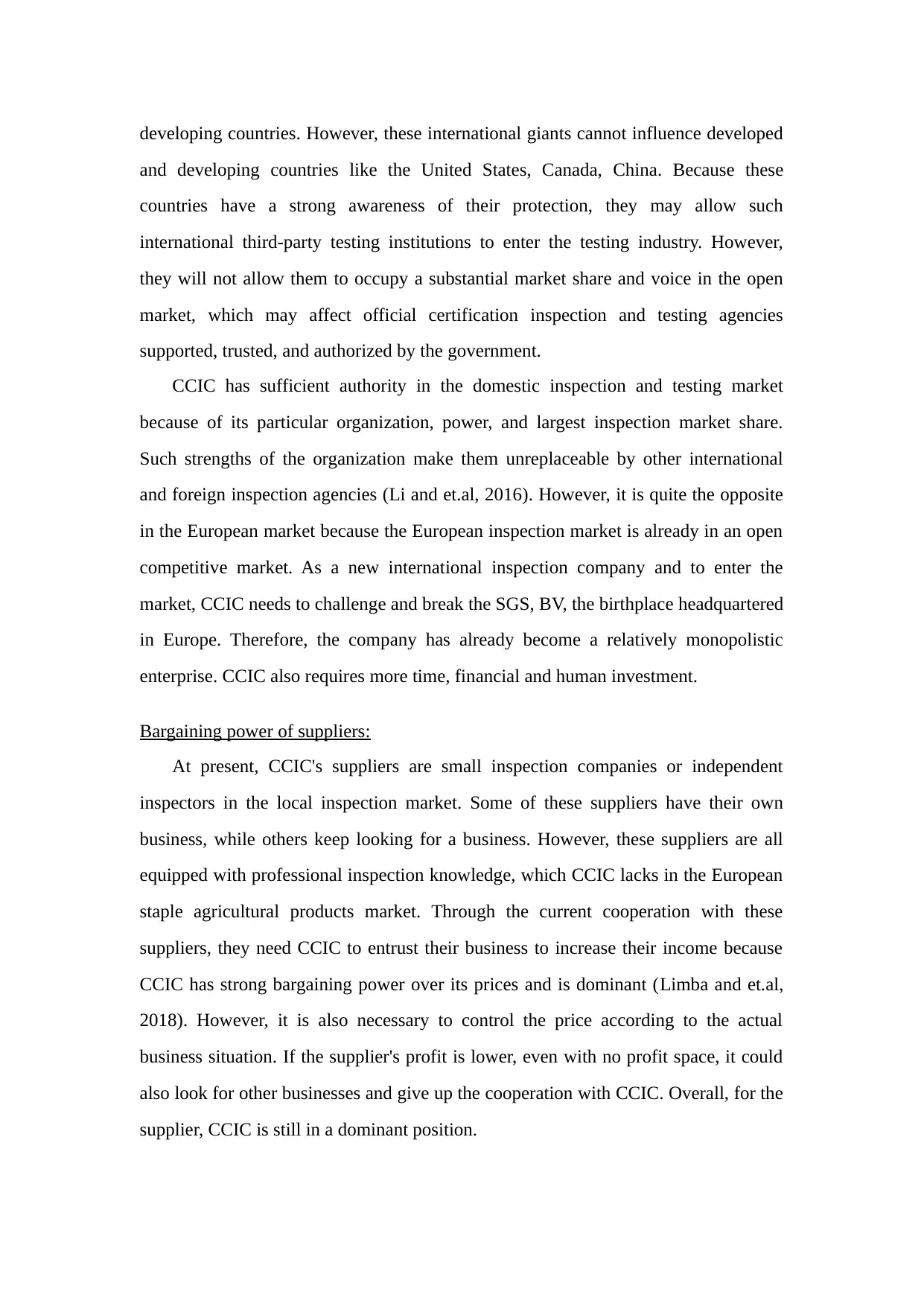
developing countries. However, these international giants cannot influence developed
and developing countries like the United States, Canada, China. Because these
countries have a strong awareness of their protection, they may allow such
international third-party testing institutions to enter the testing industry. However,
they will not allow them to occupy a substantial market share and voice in the open
market, which may affect official certification inspection and testing agencies
supported, trusted, and authorized by the government.
CCIC has sufficient authority in the domestic inspection and testing market
because of its particular organization, power, and largest inspection market share.
Such strengths of the organization make them unreplaceable by other international
and foreign inspection agencies (Li and et.al, 2016). However, it is quite the opposite
in the European market because the European inspection market is already in an open
competitive market. As a new international inspection company and to enter the
market, CCIC needs to challenge and break the SGS, BV, the birthplace headquartered
in Europe. Therefore, the company has already become a relatively monopolistic
enterprise. CCIC also requires more time, financial and human investment.
Bargaining power of suppliers:
At present, CCIC's suppliers are small inspection companies or independent
inspectors in the local inspection market. Some of these suppliers have their own
business, while others keep looking for a business. However, these suppliers are all
equipped with professional inspection knowledge, which CCIC lacks in the European
staple agricultural products market. Through the current cooperation with these
suppliers, they need CCIC to entrust their business to increase their income because
CCIC has strong bargaining power over its prices and is dominant (Limba and et.al,
2018). However, it is also necessary to control the price according to the actual
business situation. If the supplier's profit is lower, even with no profit space, it could
also look for other businesses and give up the cooperation with CCIC. Overall, for the
supplier, CCIC is still in a dominant position.
and developing countries like the United States, Canada, China. Because these
countries have a strong awareness of their protection, they may allow such
international third-party testing institutions to enter the testing industry. However,
they will not allow them to occupy a substantial market share and voice in the open
market, which may affect official certification inspection and testing agencies
supported, trusted, and authorized by the government.
CCIC has sufficient authority in the domestic inspection and testing market
because of its particular organization, power, and largest inspection market share.
Such strengths of the organization make them unreplaceable by other international
and foreign inspection agencies (Li and et.al, 2016). However, it is quite the opposite
in the European market because the European inspection market is already in an open
competitive market. As a new international inspection company and to enter the
market, CCIC needs to challenge and break the SGS, BV, the birthplace headquartered
in Europe. Therefore, the company has already become a relatively monopolistic
enterprise. CCIC also requires more time, financial and human investment.
Bargaining power of suppliers:
At present, CCIC's suppliers are small inspection companies or independent
inspectors in the local inspection market. Some of these suppliers have their own
business, while others keep looking for a business. However, these suppliers are all
equipped with professional inspection knowledge, which CCIC lacks in the European
staple agricultural products market. Through the current cooperation with these
suppliers, they need CCIC to entrust their business to increase their income because
CCIC has strong bargaining power over its prices and is dominant (Limba and et.al,
2018). However, it is also necessary to control the price according to the actual
business situation. If the supplier's profit is lower, even with no profit space, it could
also look for other businesses and give up the cooperation with CCIC. Overall, for the
supplier, CCIC is still in a dominant position.
⊘ This is a preview!⊘
Do you want full access?
Subscribe today to unlock all pages.

Trusted by 1+ million students worldwide
1 out of 20
Your All-in-One AI-Powered Toolkit for Academic Success.
+13062052269
info@desklib.com
Available 24*7 on WhatsApp / Email
![[object Object]](/_next/static/media/star-bottom.7253800d.svg)
Unlock your academic potential
Copyright © 2020–2025 A2Z Services. All Rights Reserved. Developed and managed by ZUCOL.
